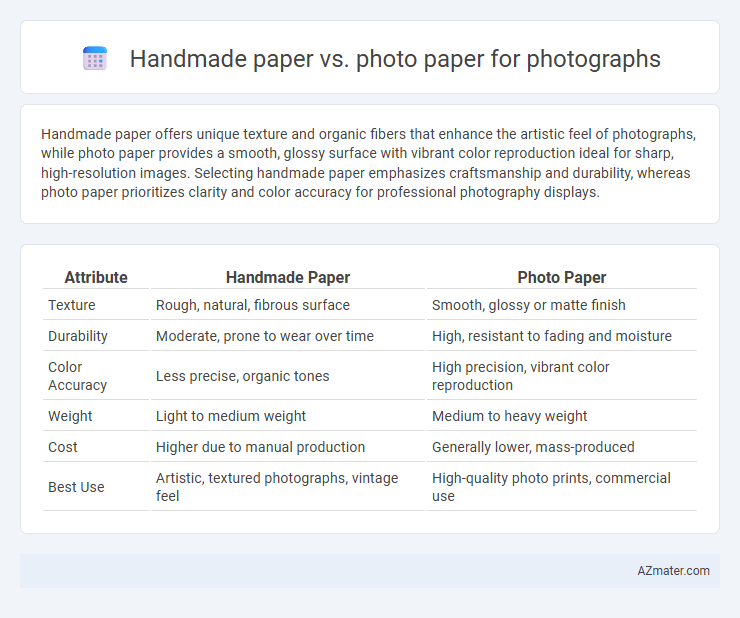Handmade paper offers unique texture and organic fibers that enhance the artistic feel of photographs, while photo paper provides a smooth, glossy surface with vibrant color reproduction ideal for sharp, high-resolution images. Selecting handmade paper emphasizes craftsmanship and durability, whereas photo paper prioritizes clarity and color accuracy for professional photography displays.
Table of Comparison
| Attribute | Handmade Paper | Photo Paper |
|---|---|---|
| Texture | Rough, natural, fibrous surface | Smooth, glossy or matte finish |
| Durability | Moderate, prone to wear over time | High, resistant to fading and moisture |
| Color Accuracy | Less precise, organic tones | High precision, vibrant color reproduction |
| Weight | Light to medium weight | Medium to heavy weight |
| Cost | Higher due to manual production | Generally lower, mass-produced |
| Best Use | Artistic, textured photographs, vintage feel | High-quality photo prints, commercial use |
Introduction to Handmade and Photo Paper
Handmade paper, crafted from natural fibers like cotton or linen, offers a unique texture and organic feel that enhances the tactile experience of photographs, making each print distinct. Photo paper, typically coated with a smooth, glossy or matte finish, is engineered for high-resolution ink absorption, resulting in vibrant colors and sharp images ideal for detailed photographic reproduction. Understanding the composition and surface qualities of both papers helps photographers select the best medium to match their creative vision and presentation needs.
Understanding Handmade Paper Qualities
Handmade paper for photographs offers unique texture and natural fiber composition that enhances visual depth and provides a tactile, artistic quality unlike the smooth, glossy finish of photo paper. Its organic structure allows for better ink absorption and longevity, making it ideal for archival or fine art prints requiring durability and a distinctive appearance. Understanding the handmade paper's thickness, cotton content, and acid-free properties is essential for selecting optimal materials that preserve photographic clarity and enrich aesthetic expression.
Characteristics of Photo Paper
Photo paper features a glossy or matte finish designed to enhance color vibrancy and sharpness, making it ideal for high-resolution photographic prints. Its coating layer improves ink absorption, preventing smudging and ensuring long-lasting image quality. Compared to handmade paper, photo paper's smooth surface and weight provide optimal durability and clarity for vivid photo reproductions.
Image Quality Comparison
Handmade paper offers a unique texture and natural fiber composition that can enhance the artistic feel of a photograph but may cause slight diffusion, leading to softer image details. Photo paper, specifically designed with a smooth, glossy or matte finish and high ink absorption, delivers sharper resolution, vibrant colors, and greater contrast, making it ideal for precise and high-quality photographic prints. The choice between handmade and photo paper depends on whether the priority is artistic texture or image sharpness and color accuracy.
Texture and Visual Appeal
Handmade paper offers a unique, tactile texture with natural fibers that produce an organic, artistic appeal enhancing the photograph's depth and character. In contrast, photo paper features a smooth, glossy or matte finish designed to deliver sharp, vibrant colors and fine details with high clarity. Choosing between handmade and photo paper depends on whether a textured, artisanal look or a polished, precise visual presentation better suits the photographic intent.
Durability and Longevity
Handmade paper consists of natural fibers that offer excellent durability, resisting wear and environmental damage, making it ideal for long-term art preservation. Photo paper, designed with glossy or matte coatings, provides vibrant image quality but is more susceptible to fading, scratching, and yellowing over time without proper care. For archival photography, handmade paper ensures superior longevity by maintaining structural integrity and color retention under varied storage conditions.
Environmental Impact
Handmade paper, crafted from recycled fibers and natural materials, offers a biodegradable and sustainable alternative that significantly reduces environmental pollution compared to photo paper. Photo paper, often coated with plastic and chemical-based inks, contributes to non-biodegradable waste and higher carbon footprints due to its manufacturing process. Choosing handmade paper supports eco-friendly photography practices by minimizing toxic waste and promoting resource conservation.
Suitability for Different Photography Styles
Handmade paper offers a unique, textured surface ideal for fine art and vintage photography styles, enhancing depth and character in prints. Photo paper provides a smooth, glossy finish perfect for high-resolution, color-rich images commonly used in commercial and portrait photography. Selecting the right paper depends on the desired aesthetic effect and durability requirements for each photography style.
Cost and Accessibility
Handmade paper often costs more due to artisanal production methods and limited availability compared to the widely accessible and mass-produced photo paper. Photo paper is easily sourced in various finishes and sizes at affordable prices from retail outlets and online stores. Choosing between the two depends on budget constraints and the desired aesthetic, with photo paper offering greater accessibility for standard photographic needs.
Final Verdict: Choosing the Right Paper for Your Photos
Handmade paper offers a unique texture and artistic appeal that enhances the tactile experience of fine art photographs, while photo paper provides vibrant colors and sharp details ideal for high-resolution prints. For archival quality and museum-grade displays, cotton-based handmade papers with acid-free properties ensure longevity without fading. Choosing between them depends on whether the priority is artistic expression or precise color reproduction, with photo paper favored for commercial prints and handmade paper preferred for gallery exhibitions.

Infographic: Handmade paper vs Photo paper for Photograph
 azmater.com
azmater.com